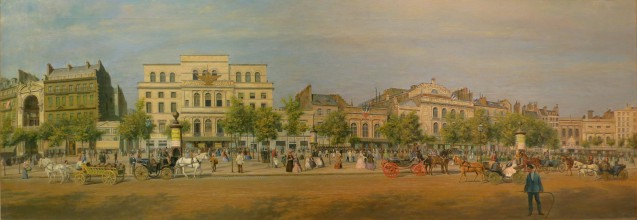This painting by Martial Potémont (1828-1883) represents the vision of the Boulevard du Temple at the beginning of 1862, just before the start of demolition work to make way for the creation of the Boulevard du Prince Eugene, named after Napoleon III’s uncle, Eugene de Beauharnais. And it was an important moment in the urban project undertaken by the Préfet de la Seine, Baron Haussmann – on the orders of the Emperor – to rationalise and sanitise the East of Paris. The Boulevard (which, in October 1870, was renamed “Boulevard Voltaire”) was designed to link the Place du Château-d’Eau (today “Place de la République”) to the Place du Trône (today “Place de la Nation”).
The course of the new Boulevard necessitated the destruction of a good part of the Boulevard du Temple, in particular the section that was home to its popular theatres. In this painting Potémont immortalised those places upon which the Boulevard du Temple’s reputation had been based since the end of the 18th century. Indeed, these theatres had been the stage of so many dramatic depictions of murders over the years that the Boulevard du Temple had become known as the “Boulevard du Crime”.
In this panorama, the artist, has immortalised, from left to right:
– the Théâtre Lyrique (former Théâtre Historique);
– the Café des Artistes (or Epi-Scié);
– the Théâtre Impérial du Cirque – on which can be seen the eagle and the name;
– the Théâtre des Folies-Dramatiques et le Théâtre de la Gaîté (former Théâtre Nicolet) – decorated with posters and tricolour flags;
– the Théâtre des Funambules;
– and the Théâtre Lazari (formerly the Théâtre des Associés).
The painter has not chosen a lugubrious atmosphere, such as might have been cast by the shadow of their imminent demolition. Rather, these south-facing buildings are imbued with a warm, bright light, and the slightly de-centred perspective of the panoramic view leads the eye from left to right, a dynamic mirrored by the contrasting movement – from right to left – caused by the direction of the traffic. Against this painted backdrop, the Boulevard is animated by elegantly dressed passers-by and horse-drawn carriages, interspersed with working people such as a municipal watercarrier dressed in overalls, a barrel carrier and a person with a basket. The choreography of social classes is played out in a visual frame punctuated by the trees and bounded by two advertising columns and two lampposts. Crowds are congregating in front of the Theatre des Folies-Dramatiques and the Théâtre de la Gaîté: a performance is about to start. All these characters and elements of decoration are staged on a beige-coloured earth, reminiscent of the warm colour of the beech wood boards of a theatre stage. In this way, Potémont transforms the Boulevard into the stage for a theatrical representation of a well-known aspect of Parisian life … albeit its last performance, before the closing of the curtains and the beginning of Haussmann’s works. Have a look at the painting in detail.
The painter and engraver Martial Potémont was known for two very different subjects: his representations of the islands of the Indian Ocean and those of the urban landscapes of Paris. Parisian by birth, the artist drew inspiration for the first theme from a period (from 1847 to 1857) he spent, from the age of twenty, on Reunion Island. The theme that dominates his later work expresses the shock he probably experienced upon his return to the metropolitan capital, Paris – which in the meantime had seen the July Monarchy, followed by the fall of the Second French Republic and finally the declaration of the Second Empire – and the ongoing economic, cultural and urban upheaval. This passing of the old city seems to have made Potémont nostalgic, as can be felt in this great painting as well as in the three hundred etchings he collected into an album called Ancien Paris (“Old Paris”) and first published in 1864.
This nostalgia for pre-Haussmann Paris was widespread in French artistic and political as soon as the first demolition works began in the 1860s. This disenchantment was fuelled by the banking crisis which resulted from real estate speculation relating to the urban development. In the end, these criticisms would lead to the removal of Baron Haussmann in January 1870: though twenty years later, the former Préfet was to try to justify his project in the second volume of his memoirs. Meanwhile, the fall of Napoleon III only added to the negative vision of the renovated capital: the elegiac perception evoked in Potémont’s painting gives way to a more vehement criticism typified by Emile Zola in La Curée. That novel, written in 1871, crudely presents Haussmannian Paris – and through it, the Second Empire – as the image of decadence and greed.
The once again Republican city of Paris purchased General view of the theatres of the Boulevard du Temple before the creation of the Boulevard du Prince Eugène from the artist in 1882, shortly before the latter’s death, and it was immediately hung in the Musée Carnavalet dedicated to the History of Paris, a museum which (with exquisite irony) had been created two years earlier, as a result of an idea thought up, in 1866, by the Baron Haussmann himself.
Marie de Bruchard, February 2017 (Trans. R. Young)


